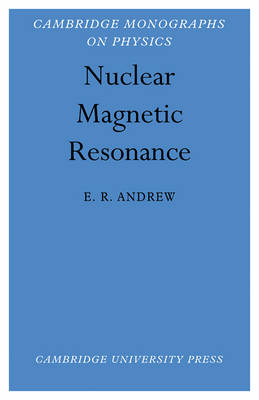
Nuclear Magnetic Resonance
Seiten
2009
Cambridge University Press (Verlag)
978-0-521-11433-2 (ISBN)
Cambridge University Press (Verlag)
978-0-521-11433-2 (ISBN)
This book examines the rotations and motions of nuclear magnetic resonance. The subject is of growing importance. Nuclear magnetic resonance has already found considerable uses in the oil industry, in industries connected with magnet construction, isotope extraction, plastics and rubber.
Like the earth itself, the nucleus of an atom frequently rotates about an axis. Under the influence of a magnetic field the axis of rotation itself rotates. The rate of this 'precessional' motion is proportional to the strength of the magnetic field and usually lies in the region of radio-frequencies. If a collection of such nuclei is placed in a magnetic field is subjected to radio waves at exactly the frequency of precession, there is a resonance effect, which can be used to measure the frequency of the precession. This effect is called nuclear magnetic resonance. The subject concerns all physicists, particularly nuclear physicists and those interested in the solid state. It is of growing importance to chemists, metallurgists and electrical engineers and there have been some biological and geophysical applications. Nuclear magnetic resonance has already found considerable uses in the oil industry, in industries connected with magnet construction, isotope extraction, plastics and rubber.
Like the earth itself, the nucleus of an atom frequently rotates about an axis. Under the influence of a magnetic field the axis of rotation itself rotates. The rate of this 'precessional' motion is proportional to the strength of the magnetic field and usually lies in the region of radio-frequencies. If a collection of such nuclei is placed in a magnetic field is subjected to radio waves at exactly the frequency of precession, there is a resonance effect, which can be used to measure the frequency of the precession. This effect is called nuclear magnetic resonance. The subject concerns all physicists, particularly nuclear physicists and those interested in the solid state. It is of growing importance to chemists, metallurgists and electrical engineers and there have been some biological and geophysical applications. Nuclear magnetic resonance has already found considerable uses in the oil industry, in industries connected with magnet construction, isotope extraction, plastics and rubber.
Author's preface; 1. Introduction; 2. Basic theory; 3. Experimental methods; 4. Measurement of nuclear properties and general physical applications; 5. Nuclear magnetic resonance in liquids and gases; 6. Nuclear magnetic resonance in non-metallic solids; 7. Nuclear magnetic resonance in metals; 8. Quadrupole effects; Appendices 1–6; Glossary of symbols; Bibliography and author index; Subject index.
| Erscheint lt. Verlag | 25.6.2009 |
|---|---|
| Reihe/Serie | Cambridge Monographs on Physics |
| Zusatzinfo | Worked examples or Exercises |
| Verlagsort | Cambridge |
| Sprache | englisch |
| Maße | 140 x 216 mm |
| Gewicht | 360 g |
| Themenwelt | Naturwissenschaften ► Chemie ► Analytische Chemie |
| Naturwissenschaften ► Physik / Astronomie ► Atom- / Kern- / Molekularphysik | |
| ISBN-10 | 0-521-11433-0 / 0521114330 |
| ISBN-13 | 978-0-521-11433-2 / 9780521114332 |
| Zustand | Neuware |
| Haben Sie eine Frage zum Produkt? |
Mehr entdecken
aus dem Bereich
aus dem Bereich


